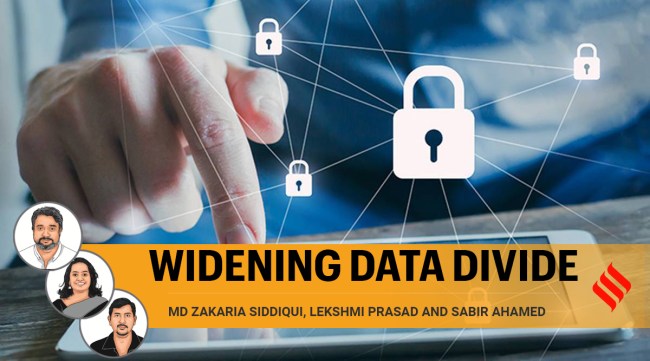Opinion Data divide between state, citizens is bad for democracy
Md Zakaria Siddiqui, Lekshmi Prasad and Sabir Ahamed write: While the government has significantly expanded its scope as the custodian of data, it is increasingly limiting the scope of access to it by responsible citizens and stakeholders
 The Indian state has been proactively strengthening the data architecture in the name of tackling corruption and better targeting of beneficiaries. (File)
The Indian state has been proactively strengthening the data architecture in the name of tackling corruption and better targeting of beneficiaries. (File) Data can improve people’s life in myriad ways, yet political factors thwart its dissemination and public usage. For example, data on migrants, meticulously collected during the pandemic, could have been used for effective public policy on migrants. While this year’s Economic Survey focuses on improving the quality and quantity of data for better and quicker assessment of the state of the economy, it pays little attention to access to the data by citizens, ignoring the criticality of data for a healthy and informed public discourse on issues of policy relevance.
Amassing of data by the government in itself will not lead to improvements, but its use by different stakeholders will. The mere fact that people have access to data is likely to act as a threat to the government to improve performance in many areas. However, generation of data doesn’t guarantee seamless access to people whose lives matter most in a democracy. Informed public discourse in any democracy is critical for accountable and transparent governance. The Right to Information is a useful instrument for citizens to access data, however it seems to be losing its teeth gradually.
The Indian state has been proactively strengthening the data architecture in the name of tackling corruption and better targeting of beneficiaries. Since 2014, the scope of UIDAI has seen a huge expansion. What we now know as JAM (Jan Dhan-Aadhaar-Mobile) has private details of citizens, breaching their fundamental right to privacy. When such integration of databases was questioned in court, the government resorted to artificial barriers and restrictions in accessing public services for those who are unwilling to share their details.
In short, the government is sufficiently empowered to collect and use information about its citizens touching all the spheres of their life. For example, an enormous amount of data was harvested by the government during the pandemic and immunisation process, conveniently overlooking privacy concerns and the risk of misuse.
Along with traditional instruments such as the Census, sample surveys and registers of various departments, the government is now armed with real time data. However, the citizen’s right to accessing relevant data for quality public discussion seems to be gradually eroding. In this process, the government has refused to hold itself accountable. This is evident from repeated events of delayed release of various survey data.
The effectiveness of state policies can be judged from the data produced by the statistical wings of the government, which have a reputation for being independent and credible. However, recent events have severely dented this perception. The government is increasingly intervening in the everyday functioning of data production for political convenience. For example, data from the consumption survey 2017-18 has not yet been released. The leaked summary results of the survey suggest some disturbing facts that may not be politically comforting for the government. Similarly, the first Periodic Labour Force Survey (PLFS 2017-18) was released only after the 2019 general election.
Further, instead of relying on the Annual Survey of Industries (ASI), a systematically designed survey for estimation of industrial sector GDP, the government has started to depend on self-reported, unverified data submitted to the Ministry of Corporate Affairs since 2011, muddling the actual status of Indian industry. Now that ASI is nearly redundant for official estimation purposes, the future of this database is uncertain. To date, ASI is the most reliable and in-depth data for research on productivity and regional patterns of the industrial sector.
Another example of undermining the scientific database is the delay in the release of Water and Sanitation Survey data 2018. The prime minister declared India open defecation free in October 2019 while the data was released much later depriving people of an opportunity to assess the status of the Swachh Bharat mission in a scientific manner.
The information gaps in the area of migration are well documented. While the JAM architecture and pandemic induced tracking tools allow for the mapping of individuals, researchers and the civil society do not have access to that information, which is useful to ascertain the level and prevalence of migration across regions within the country. The last NSS survey on migration is of 2007-08.
The indifference of the state towards the bottom half of the population is easy to gauge when one sees no effort by the government to produce data on the incidence of poverty and deprivation since the pandemic. In addition, the government has suppressed information on pandemic induced deaths.
The increasing gap in accountability of is stark in India. The autonomy of statistical agencies is compromised for immediate political gains at the cost of sustainability and quality of democratic governance. The Indian state is fast acquiring the characteristics of a surveillance state that collects data in an aggressive manner but hesitates in distributing it.
This data divide between the state and its citizens is a potential threat to the smooth functioning of a democracy. While the government has significantly expanded its scope as the custodian of data, it is increasingly limiting the scope of access to it by responsible citizens and stakeholders. Without bridging this data gap, the scope of modern technology for tracking development cannot be realised.
This column first appeared in the print edition on April 15, 2022 under the title ‘Widening data divide’. Siddiqui and Prasad are associated with Gulati Institute of Finance and Taxation, Thiruvananthapuram, Kerala and Sabir Ahamed works with Pratichi (India) Trust






